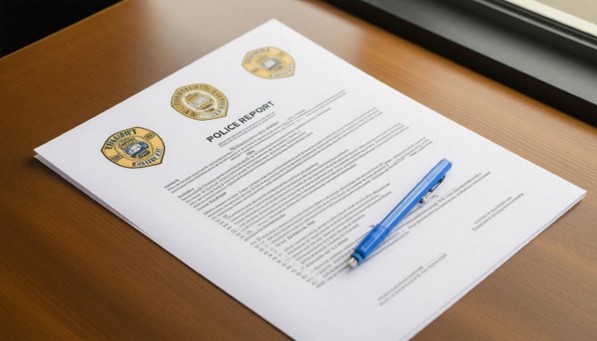Car Accident Police Report: What It Is and How to Obtain One
A car accident police report is an official document prepared by law enforcement officers at the scene of a vehicle collision, summarizing key details about the incident, such as the date, time, location, parties involved, and any observed circumstances that may have contributed to the crash. The Idaho Advocates law firm suggests that a police report serves as a vital record for insurance claims, legal matters, and potential disputes between those involved in the accident.
What is a Car Accident Police Report?
A car accident police report is not merely a collection of facts; it’s an official document crafted by law enforcement officers that serves as a comprehensive account of the incident. When a collision occurs, officers on the scene take the time to gather essential details that contribute to an accurate representation of what transpired. The report contains critical information such as the names of everyone involved, insurance details, witness accounts, and both environmental conditions and vehicle descriptions at the time of the accident.
The importance of these reports can’t be overstated, especially when considering how they assist in clarifying tricky situations. Every detail is meticulously recorded, including the date and time of the crash, which plays a crucial role in establishing timelines that are vital for both insurance evaluations and legal matters. Additionally, diagrams included in the report provide a visual layout of where each vehicle was situated at the moment of impact, which can clarify liability issues later on.
Beyond simple logistics, police reports often include statements from those involved and witnesses that present different perspectives on the incident. This multiplicity of viewpoints can shape a clearer understanding of factors like road conditions or possible distractions. Was it raining? Were there any obstructions at the intersection? By incorporating these observations into the report, law enforcement provides context that helps paint a fuller picture.
It’s interesting to note that navigating through your own police report can often shed light on aspects you might have overlooked during the chaos of a car crash. For many drivers, going through their report allows them to piece together their memories with tangible evidence, leading to a greater grasp of how events unfolded during those crucial moments.
With this foundational understanding established, let’s examine how these reports play a critical role in evaluating responsibility in collisions and their broader implications for all parties involved.
Importance of Police Reports in Car Accidents
Protecting Your Rights
One crucial reason for securing a police report after a car accident is that it acts as an impartial record of the incident. Imagine being involved in a collision and later finding out that the other driver is trying to alter their account of what happened. In such cases, having that official report provides peace of mind; it stands as a factual document that can help clarify what truly occurred, protecting your rights and interests. It’s like having an unshakable witness when everything else feels uncertain.
Facilitating Insurance Claims
The stakes are high regarding insurance claims—as nearly 6 million car accidents occur annually in the United States, according to data from the Insurance Information Institute. This staggering statistic underscores the necessity of reliable documentation because insurance companies rely heavily on police reports to substantiate claims. They will often cross-reference dates, times, and locations mentioned in the report against what both parties are claiming. Without this crucial piece of information, policyholders might find themselves at a disadvantage when attempting to settle claims or even face complications in receiving compensation.
When the right documentation is not available, disputes with insurance companies become much more complex and time-consuming.
Legal Proceedings
In the unfortunate event that your accident leads to legal proceedings—whether criminal charges against another driver or a civil suit for damages—the police report becomes an indispensable part of the evidence collection process. Car accident lawyers will typically reference this report for pertinent details: eyewitness accounts, diagrams illustrating the accident scene, and official commentary from law enforcement about conditions surrounding the crash. Having this well-rounded view helps build a stronger case and can expedite the legal process by providing concrete facts instead of relying solely on hearsay.
Understanding these aspects clarifies why obtaining your police report is essential before we explore the specific elements contained within such documents.
Key Components of a Police Report
A car accident police report is more than just a formality; it’s a crucial document filled with vital information about the incident that can play a significant role in claims and legal matters. The structure of the report reflects its wide-ranging importance, starting from the most basic yet essential details to complex accounts that give a comprehensive perspective on what transpired.
Basic Information
- The date and time of the accident, which provides chronology.
- The location of the incident, including street names and even GPS coordinates to ensure pinpoint accuracy.
- Identification details of vehicles and drivers involved, such as license plate numbers and driver’s licenses, ensuring that all parties are accounted for.
This foundational information is critical for both insurance companies and courts, establishing the framework upon which further data will build.
Statements and Witness Accounts
Then comes the rich narratives woven through detailed statements from drivers, passengers, and any witnesses present at the scene. These accounts offer multiple perspectives on the event, invaluable in case there are disputes over who was at fault or how the accident unfolded. If a pedestrian observed the crash, their input might differ from that of a driver involved, shedding light on aspects that may not be immediately apparent.
Collectively, these witness accounts add depth to the facts laid out in the report, making it more than just a dry recitation of events.
Environmental Conditions
Another critical aspect is capturing environmental conditions at the time of the incident. The report notes factors like the weather, lighting, and road conditions. All these elements can significantly influence how an accident is perceived and judged. For example, rain-slicked roads or fog might provide context for why a driver lost control or could not see another vehicle.
A clear understanding of these conditions helps both insurance adjusters and legal professionals assess blame appropriately while considering external influences.
Officer’s Diagram
Adding clarity to this already detailed narrative is an officer-drawn diagram that visually illustrates vehicle positions and damage right at the moment after impact. This visual perspective offers viewers an immediate way to comprehend how the crash occurred. It’s like looking at a live-action replay; you can visualize where each car was situated and how they interacted leading to the collision.
Though it seems straightforward, this illustration works wonders in clarifying confusion during legal discussions.
Traffic Violations
Lastly, any traffic violations arising from the incident are meticulously documented within the report. This information proves instrumental when determining liability in insurance claims. If one driver received a ticket for running a red light during the accident, it adds weight to any assertions about who may be responsible for damages or injuries incurred.
It’s essential for insurance agents to evaluate these citations thoroughly as they can ultimately influence claim decisions.
Understanding these components equips you with knowledge to navigate insurance claims effectively while preparing for any potential legal proceedings that may arise.
Legal and Insurance Uses of Police Reports
Insurance companies treat the police report as an indispensable tool in assessing claims related to car accidents. When you submit an insurance claim, the first response usually involves an insurance adjuster meticulously reviewing the report to verify the details surrounding the incident.
The police report serves to corroborate or challenge the statements given by drivers involved in the accident. If there are discrepancies—such as one driver asserting they had a green light while another insists it was red—the report becomes crucial. The lack of alignment between these accounts could delay your claim approval or even lead to denial if evidence doesn’t support either party’s position.
Determining Fault
More importantly, police reports are pivotal in determining fault in an accident. They include witness statements, diagrams drawn by officers at the scene, and detailed descriptions of vehicle damages—all contributing to a clearer understanding of what happened.
For instance, if two vehicles collided at an intersection, the positions of both vehicles, noted by the officer on-site, can provide insights into who may have violated traffic laws. However, it’s essential to recognize that while the police report is a primary piece of evidence for establishing fault, it’s not definitive; other factors such as photo evidence or expert testimonies may also influence final decisions made by insurers or juries.
In legal contexts, whether civil or criminal cases arise from a car accident, police reports play a critical role. They serve as foundational documents outlining key facts that both sides will argue over in court. For example, if the case goes to trial due to reckless driving allegations, attorneys will rely heavily on the details within the police report to advocate for their clients’ positions.
The comprehensive nature of these reports helps paint a picture that can either support claims for damages or highlight questionable actions leading up to an incident.
Individuals involved in accidents should promptly obtain this report and ensure it aligns with their recollections and available evidence. Following this crucial step is essential for navigating potential claims and legal processes ahead.



